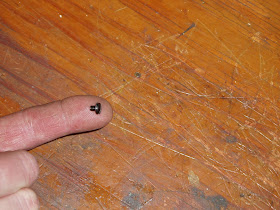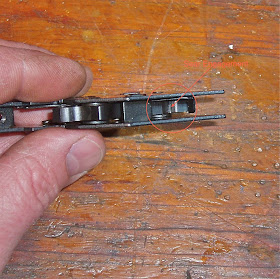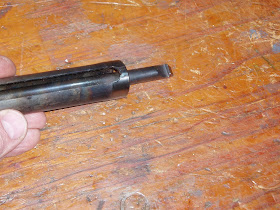
Removed the pivot bolt locking screw.

The pivot bolt head has 4 cut outs around it's circumference. The pivot bolt is snugged up to the desired tension then the locking screw is installed. The head fills into one of the radii and locks the bolt in place.

The locking screw is really tiny. I believe it's an M3x 0.5mm.

Before I remove the barrel/breech block from the compression tube, I wanted to take a look at the barrel latch. On many guns, the barrel latch itself is spring loaded and fits into a precision recess. And on many guns, that latch is pulled forward toward the muzzle to unlock the action.

Not so on the 303.

The Haenel has a spring loaded chisel shaped detent.

The latch is pushed toward the rear where it bears directly against the detent. It's a bit awkward in practice, but you get used to it.

As you push the latch rearward, it shoves the detent into the compression tube and unlocks the action.

No pressure on the latch, the detent sticks out under force from a small spring, locking the barrel in place.

Latch pushed in, pushes the detent in.

Here's a better pic of the detent with the barrel opened.

Removed the main pivot bolt and the breech/barrel unit.

A small screw secures the detent mechanism.


The chisel and the spring.

And the latch itself. Polished then reblued the sides that fit against the breech block.

Thought that the trigger could use some help. It's supposed to be a target gun after all.

There are two adjustment screws in the trigger unit. The front screw sets the amount of first stage travel.

I removed the screw and polished the end that bears on the bottom of the sear.

The rearmost screw (not well shown here) adjusts the amount of sear contact. On a target trigger, less is helpful--it shortens the amount of trigger travel in the second stage to fire the gun. Too little contact though will make the gun fire unexpectedly--like when the barrel is opened for loading. That's bad. So, I'll err on the side of caution. When the gun gets reassembled, I'll cock the gun and give it a "bump" test to see if I can make the sear slip and fire. There's no shade of gray here--it's pass or fail. Increase sear contact until it's absolutely, positively safe--then add just a tiny bit more overlap.

Trigger at rest with a ton of first stage travel. (forward screw backed out)

About that much travel. Too much for my preference. I'll screw the front adjustment in a bit further and shorten this up.

Click on this pic (or any for that matter) to enlarge it and see the circled sear contact point. This is the one spot where the trigger really should be lubed.

I used a 60% moly grease and set the trigger unit aside.

The piston got a quick polish on the front and rear.

Can really see the colors from the hardening on the body. Deburred the slot in the piston body since I was working on it.

Here's the inside of the compression tube. The transfer port hole looks awfully large.

For a target gun, the 303 is quite harsh firing and I'll venture that the transfer port hole size is to blame. Too big means that the air rushes through too fast to cushion the piston at the forward end of it's travel. The piston, instead, slams into the front of the tube. It's almost like dry firing the gun.

The hole is approximately 0.169" in diameter. For a transfer port hole in a spring piston gun, that's really large.
More soon.
No comments:
Post a Comment